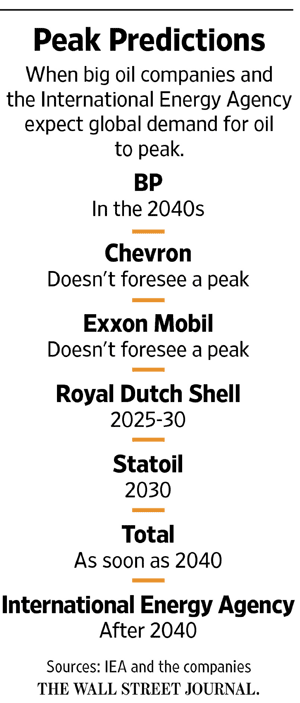In the first decade of the 2000s, there was growing concern about so-called "Peak Oil," based on a theory developed by Shell oil engineer M. King Hubbert, who in the 1940s predicted that output of oil in the lower 48 states in the US would peak in the 1970s, a projection that turned out to be spot on 30 years later – for a time.
Others jumped on the concept to predict a top for global oil output, with many in the 1990s saying that world oil production would peak about 2008.
That turned out not to be true, as fracking and other unconventional techniques greatly added to oil output, pushing prices way down.
Now, rather than concerns about Peak Oil supply sending prices way up, as we saw for a while in 2008, now the oil patch is more focused on Peak Demand – the point at which world consumption of oil reaches its inevitable peak.
A combination of more efficient car engines, a trend towards electric vehicles, rising using of solar and wind power and more have many convince Peak Demand is near – with a huge impact on society, the supply chain, the global warming discussion and more.
The Wall Street Journal reports that forecasts for peak oil demand diverge by decades. For example, the Paris-based International Energy Agency predicts that demand will grow, though slowly, past 2040.
Meanwhile, the two biggest US oil companies, Exxon Mobil and Chevron, say peak demand isn't in sight, while some big European producers predict that a peak could emerge as soon as 2025 or 2030.
A chart of various predictions for Peak Demand compiled by the Wall Street Journal is included below.
"Nobody knows" when demand will peak, Spencer Dale, group chief economist at BP, recently told the Wall Street Journal.
Of course, the point of reaching Peak Demand depends on many factors – notably government policies.

Of note is the fact that The consumption of oil in developed economies has been declining for many years.
The aforementioned BP produces what it calls the Statistical Review of World energy about this time each year, with a new edition expected as usual in mid-June.
TheGreenSupplyChain.com covers that report each year, noting last year BP's analysis showed that oil's share of world energy consumption in 2015 increased modestly for the first time since 1999, driven by dramatically falling prices.
Although oil remained the world's leading fuel in 2015, accounting for 32.9% of global energy consumption, its share of consumption has in general continued to fall, especially in developed economies. Emerging economies in fact accounted for 97% of the increase in global energy consumption in 2015 across all energy types.
It appears now that for the first time since Col. Edwin Drake jury-rigged a pipe to drill for oil in Pennsylvania in the late 1850s that oil consumption may not track overall economic growth – a profound change indeed.
Of course, among those closely tracking this trend are investors, wondering if the value of oil related companies will start to fall in the face of this trend. But supply chain practitioners need to pay close attention to, as reaching or approaching Peak Demand likely will drive prices way down – perhaps complicating the ROI on some alternative fuel programs.
And what Peak Demand will do to geopolitical issues is unclear – but worrisome. What will happen when economies such as Russia, Nigeria and those in the Middle East which depend very heavily on oil revenues see that income stream begin an inevitable decline is anyone's guess.
Perhaps in its own interests, for example, Saudi Arabia's national oil company, Saudi Arabian Oil Co., says demand is unlikely to peak before 2050, well after many other predictions.
The Wall Street Journal reports that "To predict how demand is likely to grow -or, eventually, shrink - companies are paying close attention to what most view as the momentum around the world behind regulations to limit greenhouse-gas emissions and combat rising temperatures," including the adoption of higher prices on carbon in more-developed and developing countries.
Those policies in turn will especially impact how widespread electric-vehicle adoption will be. Transport fuel accounts for about 50% of the demand for crude oil, with cars accounting for half of that; that means 25% of total oil demand hinges on autos, and about an equal amount used by trucks, for which natural gas power, hydrogen fuel cells, and even all electric technology (Tesla is developing a model) are increasingly coming into play.
On the automobile side especially, just how fast battery technology advances will greatly impact how fast consumers turn to electrics.
BP, for example, expects the number of electric cars to skyrocket to 100 million by 2035 from one million today, but says somehow even that rise will likely shave only one million to 1.5 million barrels a day off oil demand.
So no one really knows, other than it is clear Peak Oil is out, and Peak Demand is in – it is likely to be a wild ride.
What is your take on Peak Oil Demand? How soon do you expect it to be here? Let us know your thoughts at the Feedback button below.

|